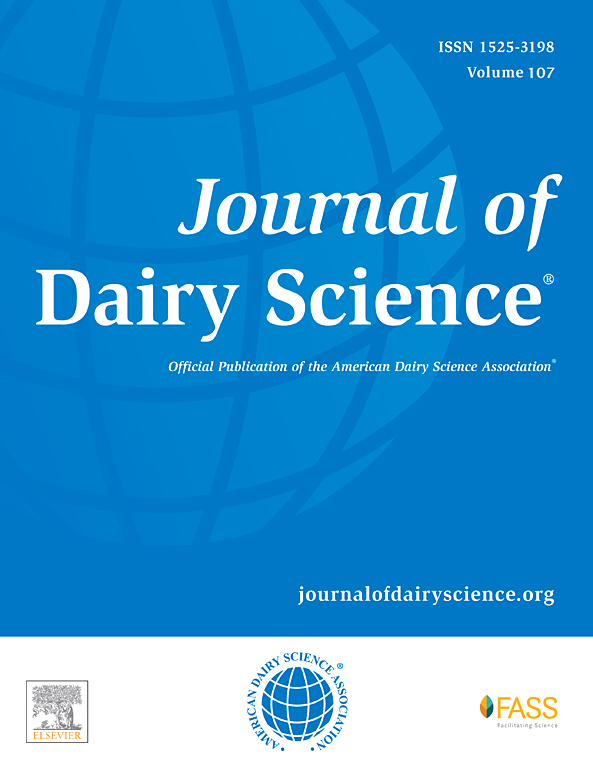根据经验得出的过滤参数、ASV 和 OTU 管道对评估瘤胃微生物多样性的影响。
IF 3.7
1区 农林科学
Q1 AGRICULTURE, DAIRY & ANIMAL SCIENCE
引用次数: 0
摘要
微生物在人类和动物健康以及动物生产力方面发挥着重要作用。反刍动物体内的宿主微生物相互作用对动物健康和生产率起着至关重要的作用,并以发酵产物的形式提供动物所需能量的 70%。因此,许多研究都对微生物群落组成进行了调查,以了解微生物群落的变化以及影响微生物定植和持久性的因素。下一代测序(NGS)技术的进步和测序成本的降低促使许多研究利用基于 16S rDNA 的分析工具,以比传统培养更精细的尺度对微生物组进行分析。然而,这种依靠单碱基对差异进行细菌类群聚类的方法可能会夸大或低估多样性,导致对细菌多样性的鉴定不准确。因此,在本研究中,我们对已知成员和丰度的模拟群落进行了测序,以确定过滤参数,从而减少由于 PCR 和测序错误造成的微生物多样性膨胀。此外,我们还在荷斯坦牛和泽西牛的研究中评估了利用已建立的生物信息学管道提出的过滤参数的效果,以确定面包和处理对细菌群落组成的影响,以及过滤对全球微生物群落结构分析和结果的影响。在使用 3 种不同的微生物分析管道(DADA2、Mothur 和 USEARCH)进行分析时,过滤导致鉴定出的细菌类群急剧减少,但保留了大部分测序数据(保留了大于 79% 的测序读数)。过滤后,α 和 β 多样性测试的结论在所有分析方法中都显示出非常相似的结果。本研究提出的基于模拟群落的过滤参数有助于对细菌多样性进行更真实的估计。此外,过滤减少了微生物组分析方法之间的差异,有助于识别微生物群落差异,而这些差异可能会因为未过滤数据中观察到的动物与动物之间的巨大差异而被忽略。因此,我们认为本研究中描述的新过滤参数将有助于获得更接近真实值的多样性估计值,并将提高检测微生物群落差异的能力,有助于更好地理解基于 16S rDNA 研究的微生物群落变化。本文章由计算机程序翻译,如有差异,请以英文原文为准。
Influence of empirically derived filtering parameters, amplicon sequence variant, and operational taxonomic unit pipelines on assessing rumen microbial diversity
Microbes play an important role in human and animal health, as well as animal productivity. The host microbial interactions within ruminants play a critical role in animal health and productivity and provide up to 70% of the animal's energy needs in the form of fermentation products. As such, many studies have investigated microbial community composition to understand the microbial community changes and factors that affect microbial colonization and persistence. Advances in next-generation sequencing technologies and the low cost of sequencing have led many studies to use 16S rDNA-based analysis tools for interrogation of microbiomes at a much finer scale than traditional culturing. However, methods that rely on single base pair differences for bacterial taxa clustering may inflate or underestimate diversity, leading to inaccurate identification of bacterial diversity. Therefore, in this study, we sequenced mock communities of known membership and abundance to establish filtration parameters to reduce the inflation of microbial diversity due to PCR and sequencing errors. Additionally, we evaluated the effect of the resulting filtering parameters proposed using established bioinformatic pipelines on a study consisting of Holstein and Jersey cattle to identify breed and treatment effects on the bacterial community composition and the impact of filtering on global microbial community structure analysis and results. Filtration resulted in a sharp reduction in bacterial taxa identified, yet retain most sequencing data (retaining >79% of sequencing reads) when analyzed using 3 different microbial analysis pipelines (DADA2, Mothur, USEARCH). After filtration, conclusions from α-diversity and β-diversity tests showed very similar results across all analysis methods. The mock community-based filtering parameters proposed in this study help provide a more realistic estimation of bacterial diversity. Additionally, filtration reduced the variation between microbiome analysis methods and helped to identify microbial community differences that could have been missed due to the large animal-to-animal variation observed in the unfiltered data. As such, we believe the new filtering parameters described in this study will help to obtain diversity estimates that are closer to realistic values, improve the ability to detecting microbial community differences, and help to better understand microbial community changes in 16S rDNA-based studies.
求助全文
通过发布文献求助,成功后即可免费获取论文全文。
去求助
来源期刊

Journal of Dairy Science
农林科学-奶制品与动物科学
CiteScore
7.90
自引率
17.10%
发文量
784
审稿时长
4.2 months
期刊介绍:
The official journal of the American Dairy Science Association®, Journal of Dairy Science® (JDS) is the leading peer-reviewed general dairy research journal in the world. JDS readers represent education, industry, and government agencies in more than 70 countries with interests in biochemistry, breeding, economics, engineering, environment, food science, genetics, microbiology, nutrition, pathology, physiology, processing, public health, quality assurance, and sanitation.
 求助内容:
求助内容: 应助结果提醒方式:
应助结果提醒方式:


